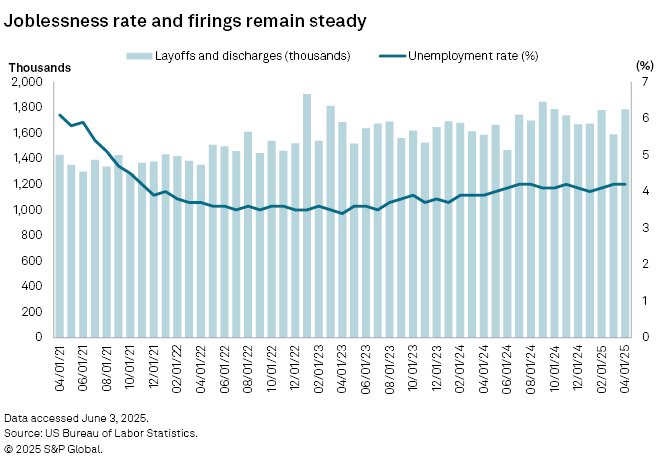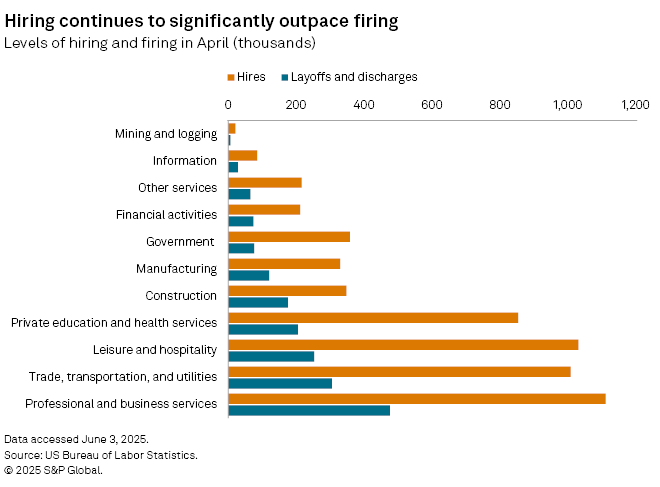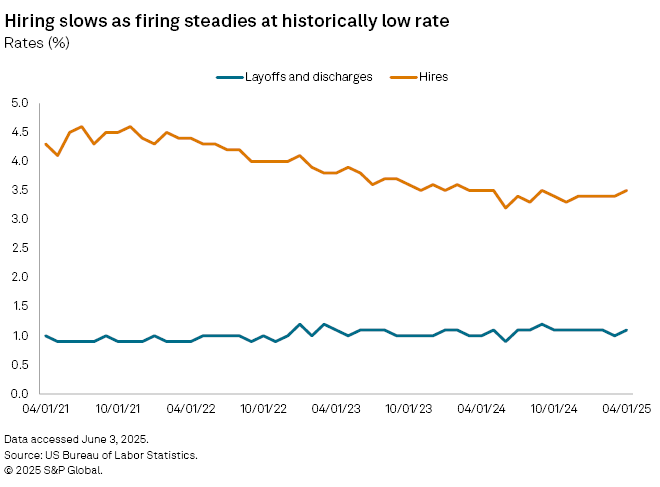Featured Topics
Featured Products
Events
S&P Global Offerings
Featured Topics
Featured Products
Events
S&P Global Offerings
Featured Topics
Featured Products
Events
S&P Global Offerings
Featured Topics
Featured Products
Events
Financial and Market intelligence
Fundamental & Alternative Datasets
Government & Defense
Banking & Capital Markets
Economy & Finance
Energy Transition & Sustainability
Technology & Innovation
Podcasts & Newsletters
Financial and Market intelligence
Fundamental & Alternative Datasets
Government & Defense
Banking & Capital Markets
Economy & Finance
Energy Transition & Sustainability
Technology & Innovation
Podcasts & Newsletters
05 Jun, 2025

By Brian Scheid
US job security is the most stable it has been in decades as policy and economic uncertainties have kept companies from imposing widespread staff cuts.
About 1.1% of employed Americans involuntarily left their jobs in April, a slight uptick from 1% in March and matching the average from the last 12 months, according to the latest US Bureau of Labor Statistics data released June 3. This post-COVID-19 rate of employers firing workers is significantly lower than the rate from the 20 years prior to the pandemic, the government data shows.
Firings and layoffs have failed to meaningfully rise despite lingering concerns of a coming recession, the Federal Reserve's plan to keep interest rates at current levels into late this year and President Donald Trump's push to impose sweeping tariffs that may lead to inflation.
Amid the current economic landscape, companies are not firing, but they are also not hiring and workers are staying put.
"The labor market is frozen in place," said Aaron Sojourner, a labor economist and senior researcher at the W. E. Upjohn Institute for Employment Research. "Huge uncertainty makes doing nothing appealing. No hiring. No firing."

From December 2000 to December 2019, the layoff and discharge rate averaged 1.4% and fell to 1.1% in only four months of the period. Over the past four years, the rate has been at 1.1% or lower in all but three months, or roughly 94% of the time, the data shows.
There were 1.79 million layoffs in the US in April, up about 200,000 a year earlier and the highest since October 2024, according to the latest US Bureau of Labor Statistics data. The modest increase came as the US unemployment rate increased to 4.2% in April 2025 from 3.9% in April 2024.
"Layoffs remain very low by historical standards — lower than you would expect given the current unemployment rate," said Guy Berger, director of economic research at the Burning Glass Institute.

The hiring rate hit 3.5% in April, an uptick from March but near its lowest level in over four years.
Companies that had challenges hiring new employees in the wake of the pandemic are keeping workers on payroll now, said Nela Richardson, chief economist with ADP, during a June 4 call with reporters.
"That was a recent lesson learned: If you lay off workers they may not come back," Richardson said.
In addition, companies are seeing relatively robust levels of productivity out of workers so there is no need to shed staffing numbers, Richardson said.

Job security may have been higher in the spring of 2023 when unemployment fell to 3.4%, its lowest level since the 1960s, and workers had more leverage to negotiate for substantially higher salaries and other incentives, such as the ability to work from home more, Richardson said.
But job security may be more stable than it has been in decades and could persist as long as the domestic economy avoids recession.
"As long as wages are robust, layoffs are low and consumers keep spending, I think even if the economy slows for a period of time it is resilient enough to rebound," Richardson said.